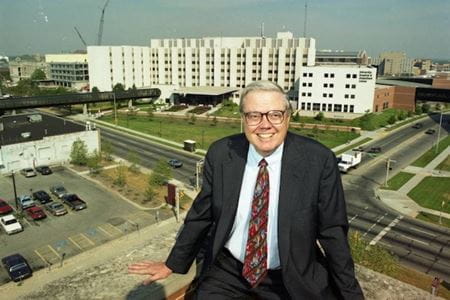Indiana University School of Medicine’s seventh dean, Walter J. Daly, MD, prioritized innovation, expanded clinical education and elevated the medical school’s visibility throughout the state as the school’s leader from 1983 until his retirement in 1995. He died on April 6, 2024, in Sarasota, Florida, at age 94, leaving a legacy of advancements for Indiana’s statewide medical school.
Developing a research-rich environment to enhance medical education was central to Daly’s leadership.
“As the current dean, I am honored to hold the title of Walter J. Daly Professor,” said IU School of Medicine Dean Jay Hess, MD, PhD, MHSA. “Dr. Daly was a very wise and admired dean.”
On the IU Indianapolis campus, the Daly Student Center and Medical Research Facility is named in his honor. During his time as dean, Daly oversaw the opening of the Medical Research and Library building in 1989 with its iconic glass pyramids and towers, heralded as “windows to the future.”
Today, as construction advances on IU School of Medicine’s new Medical Education and Research Building, the anticipation is reminiscent of what Daly and others on the Indianapolis campus felt in the late 1980s. The research space added in 1989 was designed to foster interdisciplinary collaboration, quicken discoveries in cancer and other diseases, and grow knowledge in emerging fields like medical genetics. That early emphasis laid the groundwork for a Department of Medical and Molecular Genetics which today ranks No. 5 in the nation for NIH funding.
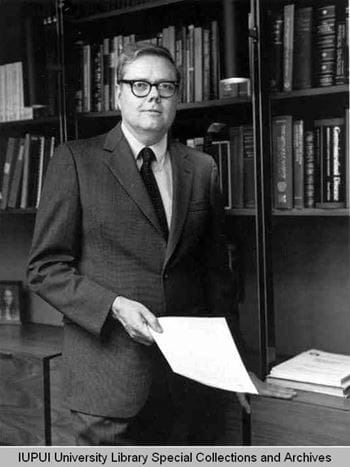 “You develop an atmosphere which is constantly seeking questions and trying to find ways to answer questions in a much broader and more fundamental way,” said Daly, describing his educational philosophy in an oral history interview recorded after his retirement.
“You develop an atmosphere which is constantly seeking questions and trying to find ways to answer questions in a much broader and more fundamental way,” said Daly, describing his educational philosophy in an oral history interview recorded after his retirement.
Daly took over as dean in July 1983, following Steven Beering’s departure to lead Purdue University. He had been on faculty since 1962, attaining full professorship in 1968, and was chair of the Department of Medicine from 1970-1983 before assuming the dual role of medical school dean and director of the IU Medical Center.
During that time, clinical operations expanded with a major addition to Riley Hospital for Children and a new outpatient wing at University Hospital. Daly was instrumental in negotiations leading to the 1997 operational merger of Riley and University hospitals with Methodist Hospital to form Clarian Health Partners, a nonprofit health care system which is now Indiana University Health. He also negotiated a contract with Wishard Hospital (now Eskenazi Health) enabling medical students to complete clinical rotations there, adding diversity to their training.
“Daly can be seen as a consensus builder, delegator, and problem solver,” writes IU Professor Emeritus of History William Schneider, PhD, in “The Indiana University School of Medicine: A History.”
Avid supporter of medical research
During his time as dean, Daly sought to grow the school’s research portfolio and established the first associate dean for research at IU School of Medicine. Daly hired a consultant with NIH grant funding experience to identify gaps in research and then recruited heavily in those areas, including neurology and molecular biology.
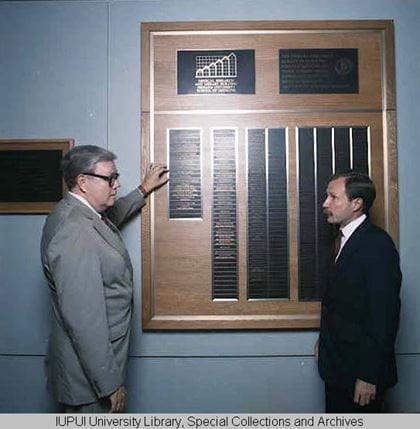 The year Daly became dean, 1983, IU School of Medicine reported research funding of $17 million. A decade later, a 1993 report showed external grant income had more than quadrupled to about $73 million. By Daly’s retirement in 1995, more than a third of full-time faculty were wholly supported by grant funding, according to Schneider’s research.
The year Daly became dean, 1983, IU School of Medicine reported research funding of $17 million. A decade later, a 1993 report showed external grant income had more than quadrupled to about $73 million. By Daly’s retirement in 1995, more than a third of full-time faculty were wholly supported by grant funding, according to Schneider’s research.
Physician scientist Harvey Feigenbaum, MD, known as the “father of echocardiography,” worked with Daly to help establish the Regenstrief Foundation, formed in 1969 through a gift from businessman Sam Regenstrief, a relative of Feigenbaum’s. The foundation sought to improve health care delivery and outcomes through interdisciplinary research.
“It was not the usual type of research,” said Feigenbaum. “Dr. Daly’s biggest contribution to the foundation was to convince the IRS we were doing legitimate medical research.”
The Regenstrief Institute would go on to develop the nation’s first critical care recovery program, one of the nation’s first electronic medical records, and one of the largest statewide health information exchanges — all aimed at making health care more accessible, efficient and equitable.
Other emerging research programs supported by Daly included the Krannert Institute of Cardiology, led by Charles Fisch, MD, a pioneer in electrophysiology who led the Division of Cardiovascular Medicine for nearly 30 years.
“Walter was familiar with the Washington scene and was very astute at securing funding from federal agencies,” Feigenbaum said.
Discovering the power of philanthropy
In the area of medical education, Daly inherited a newly expanded system — established in 1971 by the Indiana legislature — which added eight regional campuses at partner institutions throughout the state to the IU School of Medicine. This major expansion required new facilities, faculty, administrators — and funding.
 While Daly was adept at securing research grants, he knew little about how to leverage philanthropic giving, said Elizabeth Elkas, who was hired by Daly in 1987 to help build the medical school’s first fundraising program.
While Daly was adept at securing research grants, he knew little about how to leverage philanthropic giving, said Elizabeth Elkas, who was hired by Daly in 1987 to help build the medical school’s first fundraising program.
“As a grant-oriented man of science, he ultimately realized the benefit of reaping the full potential of philanthropy,” Elkas said. She was in her 20s when she began working at the school and went on to work for three subsequent IU School of Medicine deans before becoming president and CEO of Riley Children’s Foundation. “Dr. Daly was brilliant, a trailblazer, quiet but had a great sense of humor. He was a giant of a gentleman.”
At the beginning of Daly’s term, the medical school received less than $100,000 a year in charitable donations. Ten years later, in 1993, philanthropic gifts had increased to $6 million, Schneider noted.
With the help of Elkas and a gift development officer from the Indiana University Foundation, Daly launched the School of Medicine’s first capital campaign with the ambitious goal of raising $130 million. The campaign’s success provided nearly half of the $34 million needed to build the Medical Research and Library Building and ultimately raised $210 million before it ended in 1996, Elkas said.
“Dr. Daly was recognized for leading this successful campaign,” she said. “We ended up having many alumni and grateful patients participate. It really changed the optics of gift development at IU School of Medicine.”
Training up problem-solvers
In a video highlighting the Medical Research and Library Building’s advanced technology, extensive collection of medical literature and collaborative research spaces, Daly talked of challenges and opportunities in medical education — still applicable today.
 “The challenge for medical education for years to come will be to prepare students to find their way through the thicket of technology and changing business relationships, forging even stronger ties with their individual patients, all the while working daily with choices society must make about fundamental life problems,” Daly said.
“The challenge for medical education for years to come will be to prepare students to find their way through the thicket of technology and changing business relationships, forging even stronger ties with their individual patients, all the while working daily with choices society must make about fundamental life problems,” Daly said.
As a professor, Daly sought to develop problem-solving skills in his students, rather than focus on memorization of facts. In his oral history interview, Daly recalled a time he was asked to give a lecture to the beginning pharmacology class.
“What I did, in preparation, was go to the hospital and pull out 50 charts and simply make a list of the medications which the patients were taking, then try to remember how many of those I'd even heard about when I was a medical student, and it was maybe 10%,” he said.
The point he illustrated is that medical knowledge evolves quickly. “But the problem-solving, as it relates to a patient … hadn't changed an awful lot. You had different techniques, but otherwise, that's what the practical educational process is about.”
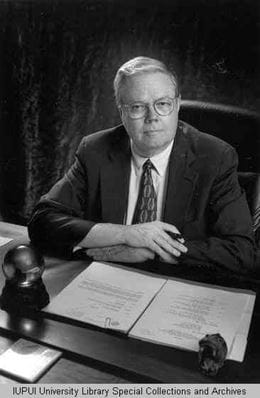 Daly encouraged students to “run as fast as you can and bite off as much as you can” when it came to exploring their individual areas of scientific interest.
Daly encouraged students to “run as fast as you can and bite off as much as you can” when it came to exploring their individual areas of scientific interest.
During his tenure, Daly forged new partnerships with hospitals and clinics across Indiana to expand residency opportunities. The goal was to keep young physicians in areas with critical shortages, particularly in rural regions of the state.
Daly also supported efforts to increase diversity among medical students, helping launch the Master of Science in Medical Science pipeline program in 1995.
For his many distinguished contributions to the university, Daly was awarded an Indiana University Bicentennial Medal in 2020, as well as an honorary Doctor of Science in 1998. He also received the IU School of Medicine Otis R. Bowen Medal in 1996.
More about Walter J. Daly, MD
Dr. Daly received all of his higher education at Indiana University, earning his bachelor’s degree in 1951 and his medical degree in 1955. He retired in 1995 as Dean Emeritus and the James O. Ritchey Professor Emeritus of Medicine.
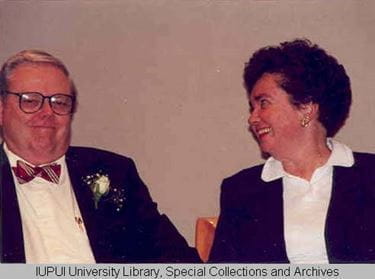 Daly was a member of the American Board of Internal Medicine and specialized in pulmonary disease. He was active in several professional organizations, including the American College of Physicians, the American Medical Association, the American Clinical and Climatological Association, the Association of American Physicians, the Central Society for Clinical Research, and the American Society for Clinical Investigation.
Daly was a member of the American Board of Internal Medicine and specialized in pulmonary disease. He was active in several professional organizations, including the American College of Physicians, the American Medical Association, the American Clinical and Climatological Association, the Association of American Physicians, the Central Society for Clinical Research, and the American Society for Clinical Investigation.
In retirement, Daly published and presented historical research as a member of the John Shaw Billings History of Medicine Society. He enjoyed writing about medieval medicine and the medical history of Indiana.
Daly was preceded in death by his wife, Joan Daly, a prominent Indianapolis realtor and school board member in Pike Township in the 1970s. They were married for 66 years and raised two daughters.
Read Walter J. Daly’s obituary at the Indy Star. Memorial donations may be made to the IU School of Medicine through the philanthropic giving program Daly initiated, which continues to support teaching and innovation at IU School of Medicine today.
